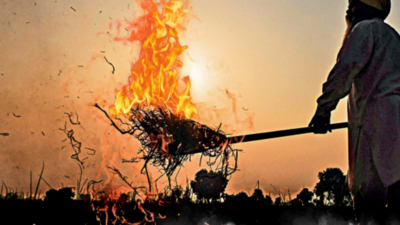- News
- City News
- chandigarh News
- Big smoke: Govt steps for crop residue burning fall short
Big smoke: Govt steps for crop residue burning fall short

Air pollution due to crop residue burning first affects the farmers and their families and livestock.
CHANDIGARH: With less than a month to go for paddy harvesting season, the spectre of crop residue burning in Punjab, Haryana, Uttar Pradesh and Rajasthan haunts the national capital region (NCR). The four states burn 3.9 crore tonnes of paddy straw every year, suffocating Delhi and parts of IndoGangetic Plains (IGP) after the Kharif harves.
Efforts fall short
The efforts for the in-situ and ex-situ management of crop residue have fallen short, while the air quality keeps worsening every winter onset. The first efforts were in 2009, when a fast depleting water table forced the Punjab government to delay paddy sowing, introduce a law for preserving subsoil water, and started transplantation from June 1 to 20 (though it kept fluctuating). Delaying transplanting by a fortnight saved Punjab 2 lakh crore litres of water but it also delayed the harvest, making the burning of stubble coincide with a period of subdued air over Delhi.
Use of crop residue
Another solution suggested was decentralised use of crop residues in coal-intensive industrial activities such as brick kilns. The second largest consumer of coal in India, the brick sector consumes 62 million tonnes of coal every year. Substitution of biomass briquettes for coal would be able to absorb a significant portion of crop residues which would otherwise have been burnt in the fields. Biomass power plants in Punjab consume 1 million metric tons of paddy straw annually out of nearly 20 million metric tons of residue generated.
Crop diversification
Experts have stressed on the need to diversify the cropping pattern, moving away from water guzzling paddy to other crops, including maize. Punjab did try to push in sunflower and maize to replace paddy, but in a half-hearted manner. A report by the Centre for Policy Research (CPR) claims there has been an ongoing effort towards crop diversification in Punjab and Haryana, owing to the groundwater crisis. This diversification appears to have been accelerated by the Covid-linked disruptions. Absence of migrant labour for transplanting paddy in June-July owing to the lockdown had further increased the cultivated area for alternative crops like maize and cotton.
‘Need holistic approach’
Air pollution due to crop residue burning first affects the farmers and their families and livestock. The solutions require a holistic approach having both short and long-term planning with systematic implementation on the ground. Incentive should be given to crop diversification, which is more sustainable and would be a step ahead in moving from food security to nutrition security
Significant rise in burning incidence: Study
The study done in partnership with Kings College University of Leicester, London, Panjab University and PGIMER Chandigarh shows that beyond meteorology, the area and amount of residue burned has increased significantly over the past almost two decades, mirroring government statistics on increasing crop yields.
Efforts fall short
The efforts for the in-situ and ex-situ management of crop residue have fallen short, while the air quality keeps worsening every winter onset. The first efforts were in 2009, when a fast depleting water table forced the Punjab government to delay paddy sowing, introduce a law for preserving subsoil water, and started transplantation from June 1 to 20 (though it kept fluctuating). Delaying transplanting by a fortnight saved Punjab 2 lakh crore litres of water but it also delayed the harvest, making the burning of stubble coincide with a period of subdued air over Delhi.
Use of crop residue
Another solution suggested was decentralised use of crop residues in coal-intensive industrial activities such as brick kilns. The second largest consumer of coal in India, the brick sector consumes 62 million tonnes of coal every year. Substitution of biomass briquettes for coal would be able to absorb a significant portion of crop residues which would otherwise have been burnt in the fields. Biomass power plants in Punjab consume 1 million metric tons of paddy straw annually out of nearly 20 million metric tons of residue generated.
Crop diversification
Experts have stressed on the need to diversify the cropping pattern, moving away from water guzzling paddy to other crops, including maize. Punjab did try to push in sunflower and maize to replace paddy, but in a half-hearted manner. A report by the Centre for Policy Research (CPR) claims there has been an ongoing effort towards crop diversification in Punjab and Haryana, owing to the groundwater crisis. This diversification appears to have been accelerated by the Covid-linked disruptions. Absence of migrant labour for transplanting paddy in June-July owing to the lockdown had further increased the cultivated area for alternative crops like maize and cotton.
‘Need holistic approach’
Air pollution due to crop residue burning first affects the farmers and their families and livestock. The solutions require a holistic approach having both short and long-term planning with systematic implementation on the ground. Incentive should be given to crop diversification, which is more sustainable and would be a step ahead in moving from food security to nutrition security
Significant rise in burning incidence: Study
The study done in partnership with Kings College University of Leicester, London, Panjab University and PGIMER Chandigarh shows that beyond meteorology, the area and amount of residue burned has increased significantly over the past almost two decades, mirroring government statistics on increasing crop yields.
FOLLOW US ON SOCIAL MEDIA
FacebookTwitterInstagramKOO APPYOUTUBE
Start a Conversation
end of article









